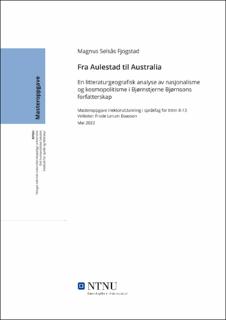| dc.contributor.advisor | Boasson, Frode Lerum | |
| dc.contributor.author | Fjogstad, Magnus Selsås | |
| dc.date.accessioned | 2022-08-04T17:19:31Z | |
| dc.date.available | 2022-08-04T17:19:31Z | |
| dc.date.issued | 2022 | |
| dc.identifier | no.ntnu:inspera:107178568:20966026 | |
| dc.identifier.uri | https://hdl.handle.net/11250/3010210 | |
| dc.description.abstract | Denne oppgaven undersøker kosmopolitiske og nasjonalistiske impulser i Bjørnstjerne Bjørnsons forfatterskap fra et litteraturgeografisk perspektiv. Det blir gjort gjennom å kombinere nye digitale metoder med tradisjonell nærlesning av det sene dramaet Daglannet (1904). Ved hjelp av de digitale metodene blir alle stedsnavn i Bjørnsons forfatterskap kartlagt og kvantifisert. Resultatet viser at Norge og Christiania er de stedene som nevnes mest, men at oppmerksomheten hovedsakelig er rettet mot diverse europeiske land og storbyer. Den digitale makroundersøkelsen gir dermed ingen klar indikasjon på om nasjonalismen eller kosmopolitismen er mest fremtredende hos Bjørnson, men viser heller at forholdene er lagt til rette for både et nasjonalistisk og et kosmopolitisk forfatterskap. Nærlesningen av Daglannet (1904) ble min metode for å undersøke om en grundigere analyse av forfatterskapets stedsbeskrivelser kunne gi et utslag i en av retningene. Analysen viser at de utenlandske stedene blir fremstilt som noe friere, lysere og langt på vei bedre enn de norske. I tillegg er det flere eksempler hvor utenlandske impulser bidrar med løsningen på problemer som oppstår på Daglannet. Samlet sett er det derfor mye som underbygger at det er en kosmopolitisk norm som dominerer i Daglannet. | |
| dc.description.abstract | This thesis examines cosmopolitan and nationalist impulses in Bjørnstjerne Bjørnson's writing from a literary geographical perspective. This is done by combining new digital methods with traditional close reading of the late drama Daglannet (1904). Using the digital methods, all place names in Bjørnson's authorship are mapped and quantified. The results show that Norway and Christiania are the places most mentioned, but that the focus is mainly on various European countries and cities. Thus, the digital macro survey gives no clear indication of whether nationalism or cosmopolitanism is most prominent, but rather shows that the conditions have been established for both a nationalist and a cosmopolitan authorship. The close reading of Daglannet became my method of investigating whether a more thorough analysis of the authorship´s geographical descriptions could point towards one of them. The analysis shows that the foreign places are presented as more liberal, brighter and overall improved compared to Norway. In addition, there are several examples where foreign impulses contribute to the solution of problems that arise in Daglannet. Overall, there is therefore much to support that it is a cosmopolitan norm that dominates in Daglannet. | |
| dc.language | nob | |
| dc.publisher | NTNU | |
| dc.title | Fra Aulestad til Australia - en litteraturgeografisk analyse av nasjonalisme og kosmopolitisme i Bjørnstjerne Bjørnsons forfatterskap | |
| dc.type | Master thesis | |
